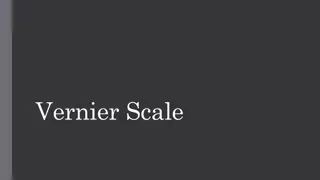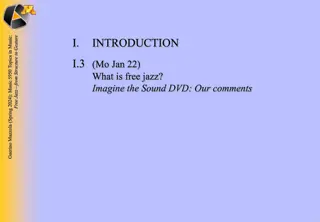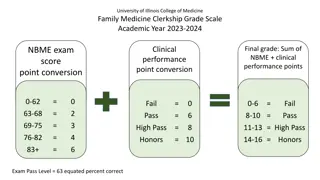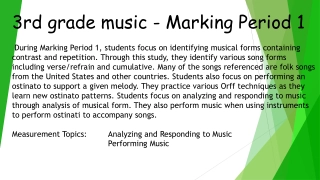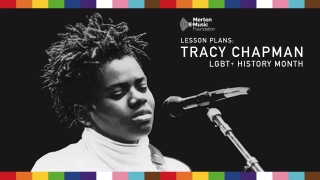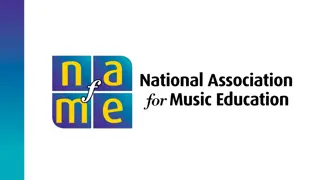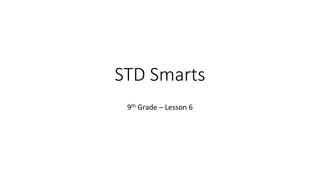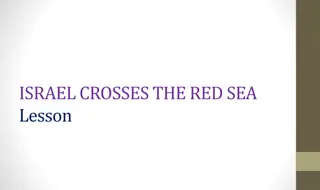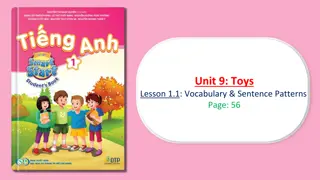Exploring Chords and Scales: Music Lesson for Year 7 and 8
Delve into the world of chords and scales with this comprehensive music lesson for Year 7 and 8 students. Learn about key terminology, qualities of the C Major scale, and chord progressions in the key of C. Engage in practical activities on the piano or guitar to enhance your understanding of music theory concepts.
Download Presentation
Please find below an Image/Link to download the presentation.
The content on the website is provided AS IS for your information and personal use only. It may not be sold, licensed, or shared on other websites without obtaining consent from the author. Download presentation by click this link. If you encounter any issues during the download, it is possible that the publisher has removed the file from their server.
Presentation Transcript
Year 7 and 8 Music: Becoming a SongMaker LESSON RESOURCE PACKAGE 3 LESSONS Three Chords for a Million People
Lesson One Starting with scales, keys and chords
Learning Intention: To define key terminology associated with scales, keys and chords. To identify and discuss the qualities of the C Major scale. To identify and discuss the scale degrees of the C Major scale. To identify and discuss the chord qualities of C Major, F Major, G Major and A minor (chords I, IV, V and vi) in the key of C. Success Criteria: I can recall and define key terminology associated with scales, keys and chords from a glossary. I can demonstrate my understanding of the qualities of the C Major scale by completing the activity in class and engaging with the discussion. I can demonstrate my understanding of the scale degrees of the C Major scale by completing the activity in class and engaging with the discussion. I can demonstrate my understanding of the chord qualities of C Major, F Major, G Major and A minor (chords I, IV, V and vi) in the key of C through practical application on the piano or the guitar.
Words of the Day Scale - any set of musical notes ordered by fundamental frequency or pitch. Interval the measurement between two notes (e.g. a third apart) Triad - a set of three notes that can be stacked vertically in thirds. Chord - three or more single pitches heard simultaneously. Key - a system of functionally related chords deriving from the major and minor scales, with a central note, called the tonic. ChordProgression - a chord progression or harmonic progression (informally chord changes, used as a plural) is a succession of chords.
Starting in C For this lesson we will start by looking at the C Major Scale. Otherwise known as all of the white notes on the piano from from C to C. It looks like this on a keyboard and on a musical staff in the treble clef.
Making Triads Our next step is to create triads on top of each note in the C Major scale to make the chords in the key of C.
C Major Chord Summary Here is a quick summary of how to make triads in the key of C, build off the C Major scale. ACTIVITY AND DISCUSSION Can you copy down the chord triads into your workbook so that you can try them out on the guitar or piano later this lesson. Daniel, S. (2012, August 27). Building Chords, Easy Music Theory. YouTube. Retrieved January 7, 2023, from https://www.youtube.com/watch?v=__VtlxQZhXs
Learning Chords For this lesson, we will learn how to play four chords in the key of C. We use roman numerals to number our chords (based on their scale degree). The four chords we will learn on the piano or guitar are: C Major (Chord I): C E G F Major (Chord IV): F A C G Major (Chord V): G B D A minor (Chord vi): A C E When we learn these four chords we can later develop a chord progression that we can use to create our song concepts.
Chords I, IV, V and vi C Major F Major C Major F Major A minor G Major G Major A minor
Experiment and Practice For the remainder of this lesson you can choose a guitar or piano to learn the four chords. Here are a few tips to help learning the chords: ON PIANO Try and learn the chords on your right hand. Keep your thumb at the bottom (on the root note of the chord). Remember the shape of your fingers. Move you fingers up the piano to play the root position chords. ON GUITAR Learn the chords with the fingers according to the diagrams. Keep your thumb to the back of the neck of the guitar and use the tips of your fingers. Try and strum the whole chord four times and move onto the next one.
Lesson Two Progressing to the Progression
Learning Intention: To identify and analyse common I, V, vi and IV (four chord formula) chord progressions in popular songs. To experiment and improvise with variations of the I, V, vi and IV (four chord formula) chord progression on piano or guitar Success Criteria: I can identify and explain how common I, V, vi and IV (four chord formula) chord progressions are used in popular songs. I can demonstrate my practical application of the I, V, vi and IV (four chord formula) chord progression by experimenting and improvising variations on the piano or guitar as a basis to developing a song idea.
The Chord Progression In this video Linda and Dan explore the chord progression as they work with Simon Cohen in the studio producing a song. CLASS DISCUSSION Does limiting the chords used in a song make a song any less interesting? *watch to 6:30 triple j. (2018, August 28). How do you write a hit song? | What is Music. YouTube. Retrieved January 7, 2023, from https://www.youtube.com/watch?v=iIBMi8LrkOM
The I V vi IV Progression In this video from Hook Theory, the I V vi IV chord progression is analysed and discussed. ACTIVITY Can you research other songs that have used the popular I V vi IV chord progression. *watch to 3:40 David Bennett Piano. (2022, March 23). 7 super common chord progressions and why they work. YouTube. Retrieved January 7, 2023, from https://www.youtube.com/watch?v=Vyc8lezaa9g
Creating a Chord Progression Returning to the four chords in the key of C that we explored last lesson the next goal is to create our own variation of the chord progression. We can do this on the piano or the guitar by experimenting with the following: Changing the duration that we play each chord. Creating a rhythm that we can use to play each chord. The chords are presented on the next page as a guide to experiment and improvise on the guitar or piano, different methods of playing or creating our own chord progression using the chords I, IV, V and vi.
Chords I, IV, V and vi C Major F Major C Major F Major A minor G Major G Major A minor
Enter the Playground Without an instrument, you can experiment with chord progressions and harmonic ideas by returning to Ableton s learning music platform The Playground here: https://learningmusic.ableton.com/ the-playground.html ACTIVITY Try experimenting with chord triads and variations over a one bar phrase in C Major.
Lesson Three Four chord formulas
Learning Intention: To investigate the four chord formula in developing two contrasting sections of music. To experiment with chord variations (inversions, register and positions) of the four chord formula on the piano or the guitar in developing two contrasting sections of music as a basis for developing song ideas. Success Criteria: I can practically demonstrate the basic four chord formula on a piano or guitar. I can experiment with chord variations (inversions, register and positions) on the piano or the guitar to help develop two contrasting harmonic ideas as a basis for a song.
Words of the Day Inversion rearrangement of the top-to-bottom elements of a chord. Position a way of expressing where fretting fingers are placed in relation to frets. Variation - a formal technique where material is repeated in an altered form. Arpeggiate - a manner of performing a chord. Where the chord is broken into notes and performed sequentially rather than simultaneously. Demo a rough musical idea recorded to capture a moment for future production or development.
Creating Variations Returning to the four chords in the key of C that we explored last lesson the next goal is to create our own variation of the chord progression. We can do this on the piano or the guitar by experimenting with the following: Exploring different inversions of the chord (alternative ways of spelling the chord so that the root note changes). You could arpeggiate the chords on the guitar (fingerstyle) or the piano to break the chord up and create space. Exploring different ways to play the chord on the guitar on different positions on the guitar (change in register - higher or lower pitched). The chords are presented on the next page as a guide to experiment and improvise on the guitar or piano, different methods of playing or creating our own chord progression using the chords I, IV, V and vi.
Inversions - Piano Here are the chords C, F, G and A minor written in root position, 1st inversion and 2nd inversion:
Chord Variations - Guitar Inversions aren t as easy on the guitar, though we can approach the four chords differently by starting with power chords (or 5th chords) and expanding to bar chords if advanced. Here are the chords C, F, G and A minor as power chords:
The Bass Line Other great way of changing the colour of our chord is to work with developing bass lines. A bass line can help strengthen the sound of our chord. A bass line can add movement to our chord progression. A bass line can change the tonic of a chord and create a tonality that we couldn t have heard with only a chord triad. *watch to 0:50 triple j. (2018, August 28). How do you write a hit song? | What is Music. YouTube. Retrieved January 7, 2023, from https://www.youtube.com/watch?v=iIBMi8LrkOM ACTIVITY Can you explore some bass line ideas to help develop your chord progression?
Borrowing Chords Sometimes if you re really stuck, you can borrow chords from other songs you like and re-purpose them to fit some of your own ideas. Here s Keppie and Ben from How to Write Songs, talking more about how to explore this technique. *Watch to 6:30 ACTIVITY Can you hear any similarities to your chord progression to another you already know? How might you change the way you play the chords or alter some details to create a more original sound? *watch to 6:30 How To Write Songs. (2022, January 2). How to Write Songs 4 Ways to Start a Song. YouTube. Retrieved January 7, 2023, from https://www.youtube.com/watch?v=wSrB3XoAOqU
Developing Your Song Now you have a groove to work with and have learned a few basic chords to get your started, you re ready to start writing a section of your song and developing some ideas. Here are a few ways of approaching writing your own chord progression in the key of C over your drum groove: Open your DAW and loop a drum groove (or return to the Ableton Playground). Improvise your chord progression over your drum groove and come up with some variations of chords. When you re happy with an idea hit record on your DAW and record the piano or guitar via the microphone on the computer (or phone) to get the demo down. Practice with a friend and share ideas by combining piano and guitar to create new chord textures and ideas.





